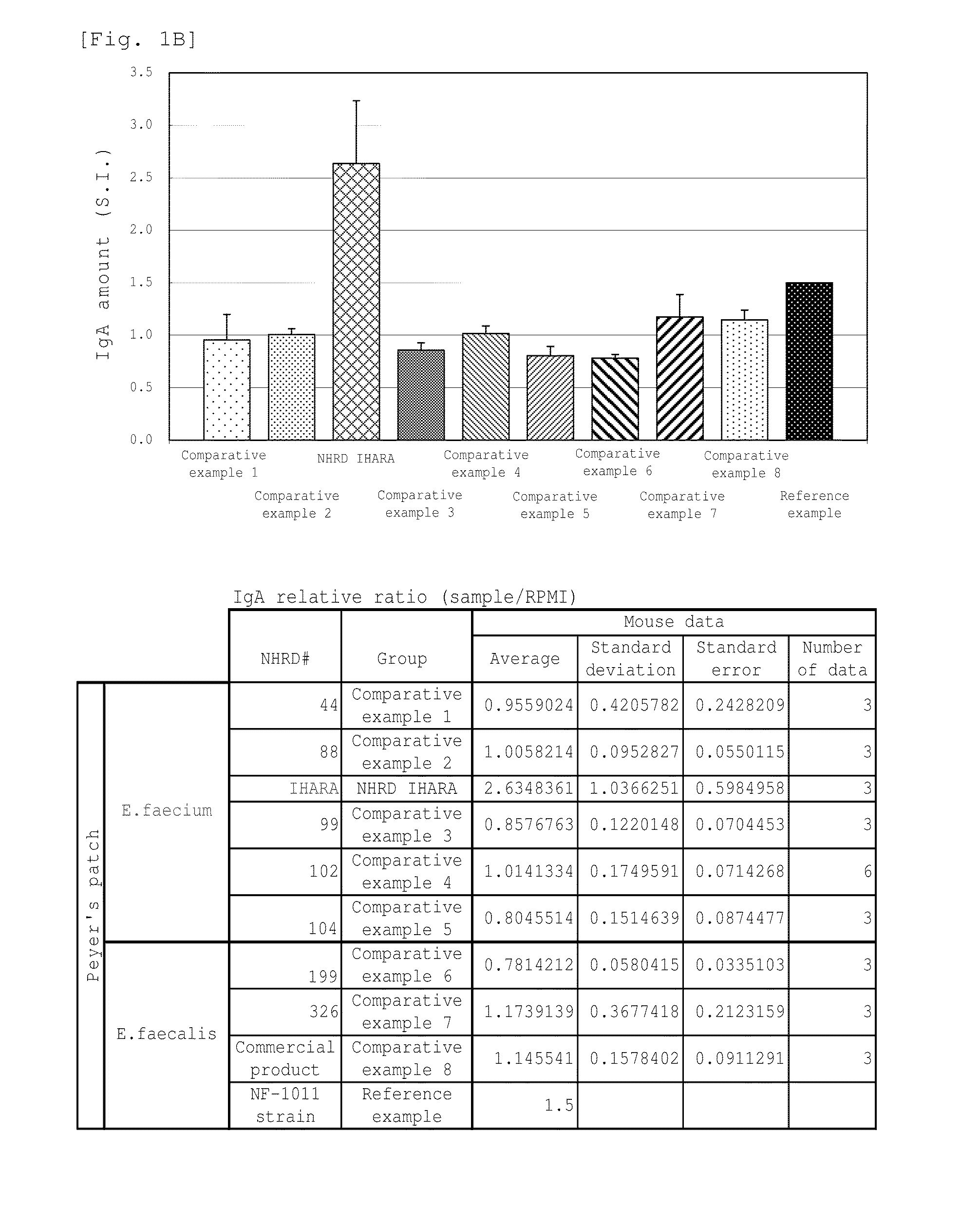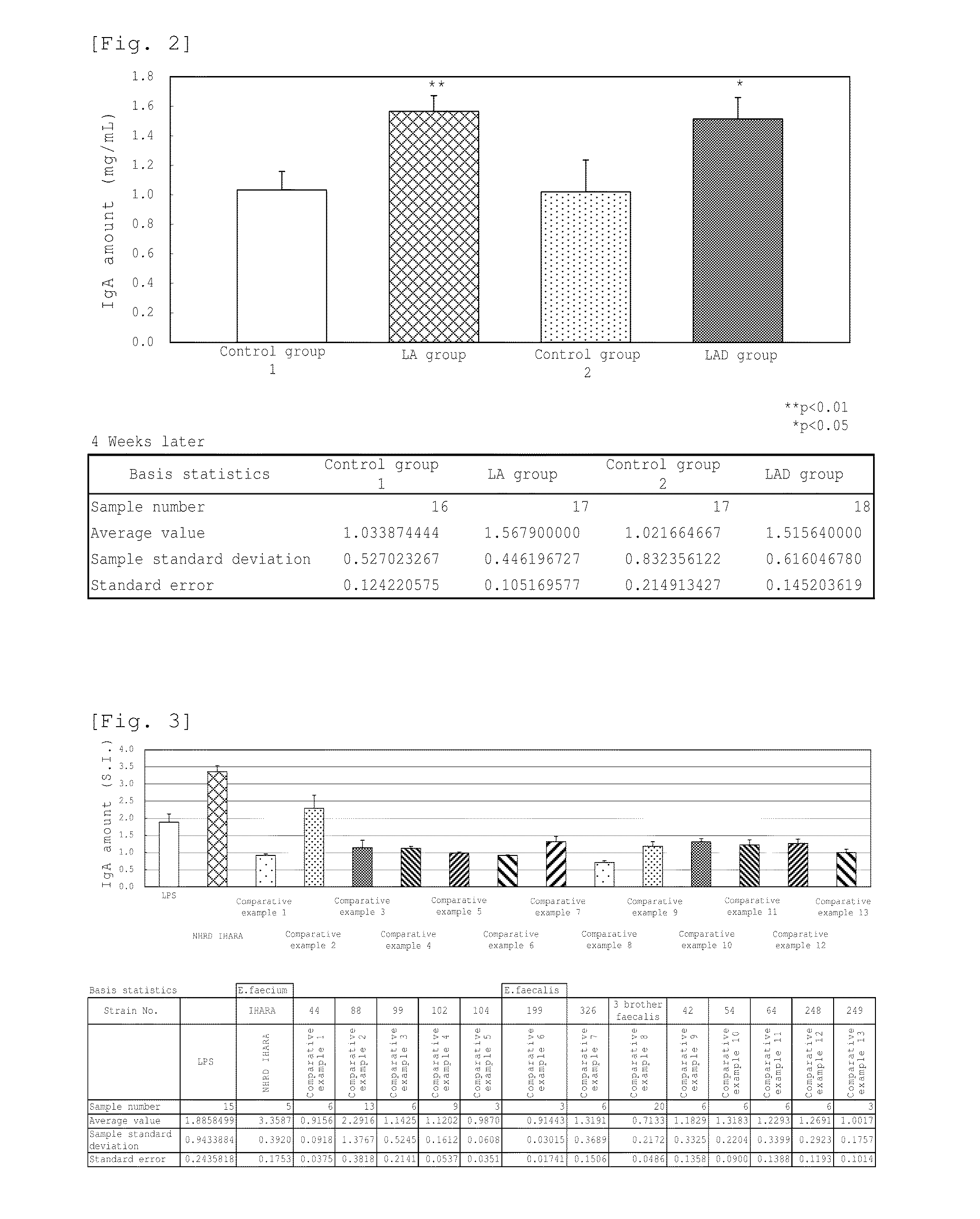Novel lactic acid bacterium having high immunoglobulin-a-inducing ability
a lactic acid bacterium and immunoglobulin-a-inducing technology, which is applied in the field of new lactic acid bacterium with high immunoglobulin-a-inducing ability, can solve the problems of low resistance to foreign materials from the outside, increase in accident rate or reduction in body weight gain, and yield low productivity, so as to achieve high immunostimulating effect, high iga production-inducing ability, and high enteric colonization rate
- Summary
- Abstract
- Description
- Claims
- Application Information
AI Technical Summary
Benefits of technology
Problems solved by technology
Method used
Image
Examples
example 1
Screening of Enterococcus faecium NHRD IHARA of the Invention
[0110]The excretions of livestock and livestock products were diluted 10 times with sterilized physiological saline, and 10 μl of the solution was cultured on BL agar medium for three days. After isolating 400 colonies of the lactic acid bacterium, the bacterium strain forming each colony was temporarily named as NHRD 1 to 400. Further, the term “lactic acid bacterium” used herein refers to the gram-positive and anaerobic bacterium which does not form any catalase and produces an acid in the medium. These isolated lactic acid bacteria were found to be the lactic acid bacteria encompassing various genera such as the genus Lactobacillus, genus Lactococcus, and genus Bifidobacterium, in addition to the genus Enterococcus. The name of Enterococcus faecium NHRD IHARA related to the invention was given to the bacterium strain which is selected as a bacterium strain showing significantly high IgA production amount according to th...
example 2
Production of Dried Cell Bodies of Enterococcus faecium NHRD IHARA (Vital Cells)
[0112]Enterococcus faecium NHRD IHARA was inoculated to the MRS liquid medium having the composition described below (cell number: 102 cells / ml), and incubated at 37° C. for 16 to 20 hours to obtain the culture medium containing about 109 vital cells / ml. Thus obtained culture medium was centrifuged for 20 minutes at 12,000×g to collect the cells, which were then washed twice with distilled water to give the cell bodies. The resulting cell bodies were suspended in distilled water, and then freeze-dried to give the dried cell bodies (hereinafter, “dried vital cells”).
[0113]Composition of the MRS liquid medium is described as follows:
Pancreatine-digested product of gelatin10gBeef extract8gYeast extract4gGlucose18.5gPotassium hydrogen phosphate3gPolysorbate 80 (surface active agent)1gSodium acetate3gAmmonium citrate2gMagnesium sulfate0.2gManganese sulfate0.05gDistilled water1000 ml
(adjusted to pH 6.2, and he...
example 3
Production of Dried Cell Bodies of Enterococcus faecium NHRD IHARA (Dead Cells)
[0114]The vital cell bodies which had been obtained in the same manner as Example 2 were suspended in distilled water, heated at 100° C. for 30 minutes, and then freeze-dried to give the dried dead cell bodies (hereinafter, referred to as “dried dead cells”).
PUM
| Property | Measurement | Unit |
|---|---|---|
| temperature | aaaaa | aaaaa |
| temperature | aaaaa | aaaaa |
| pH | aaaaa | aaaaa |
Abstract
Description
Claims
Application Information
 Login to View More
Login to View More - R&D
- Intellectual Property
- Life Sciences
- Materials
- Tech Scout
- Unparalleled Data Quality
- Higher Quality Content
- 60% Fewer Hallucinations
Browse by: Latest US Patents, China's latest patents, Technical Efficacy Thesaurus, Application Domain, Technology Topic, Popular Technical Reports.
© 2025 PatSnap. All rights reserved.Legal|Privacy policy|Modern Slavery Act Transparency Statement|Sitemap|About US| Contact US: help@patsnap.com



